ENG305 Safety, Risk & Reliability: Risk Assessment Report on Hazards
VerifiedAdded on 2023/06/04
|24
|4409
|76
Report
AI Summary
This risk assessment report identifies and analyzes environmental, fire, and explosion hazards within a process plant, evaluating their likelihood and consequences. The report covers fire hazards due to equipment failure and improper handling of materials, environmental hazards from waste products and emissions, and operational hazards including employee sabotage and data loss. Risks are prioritized based on a likelihood-consequence matrix, and risk values are calculated. The report concludes by highlighting the need for immediate action on high-risk areas like waste management and data protection, while recommending routine procedures for low-risk hazards. The analysis uses a risk matrix to categorize and prioritize hazards, providing a structured qualitative assessment of operational environments.
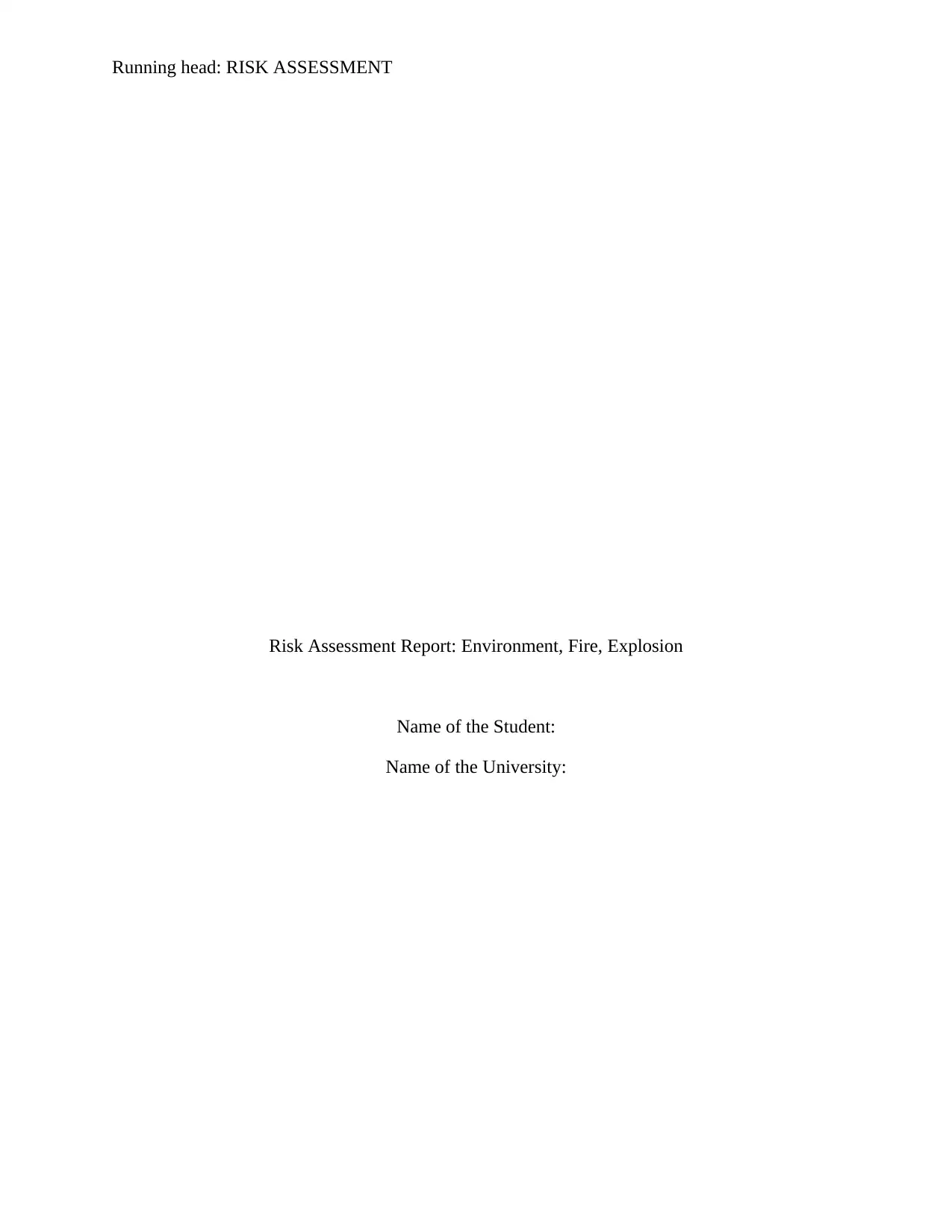
Running head: RISK ASSESSMENT
Risk Assessment Report: Environment, Fire, Explosion
Name of the Student:
Name of the University:
Risk Assessment Report: Environment, Fire, Explosion
Name of the Student:
Name of the University:
Paraphrase This Document
Need a fresh take? Get an instant paraphrase of this document with our AI Paraphraser
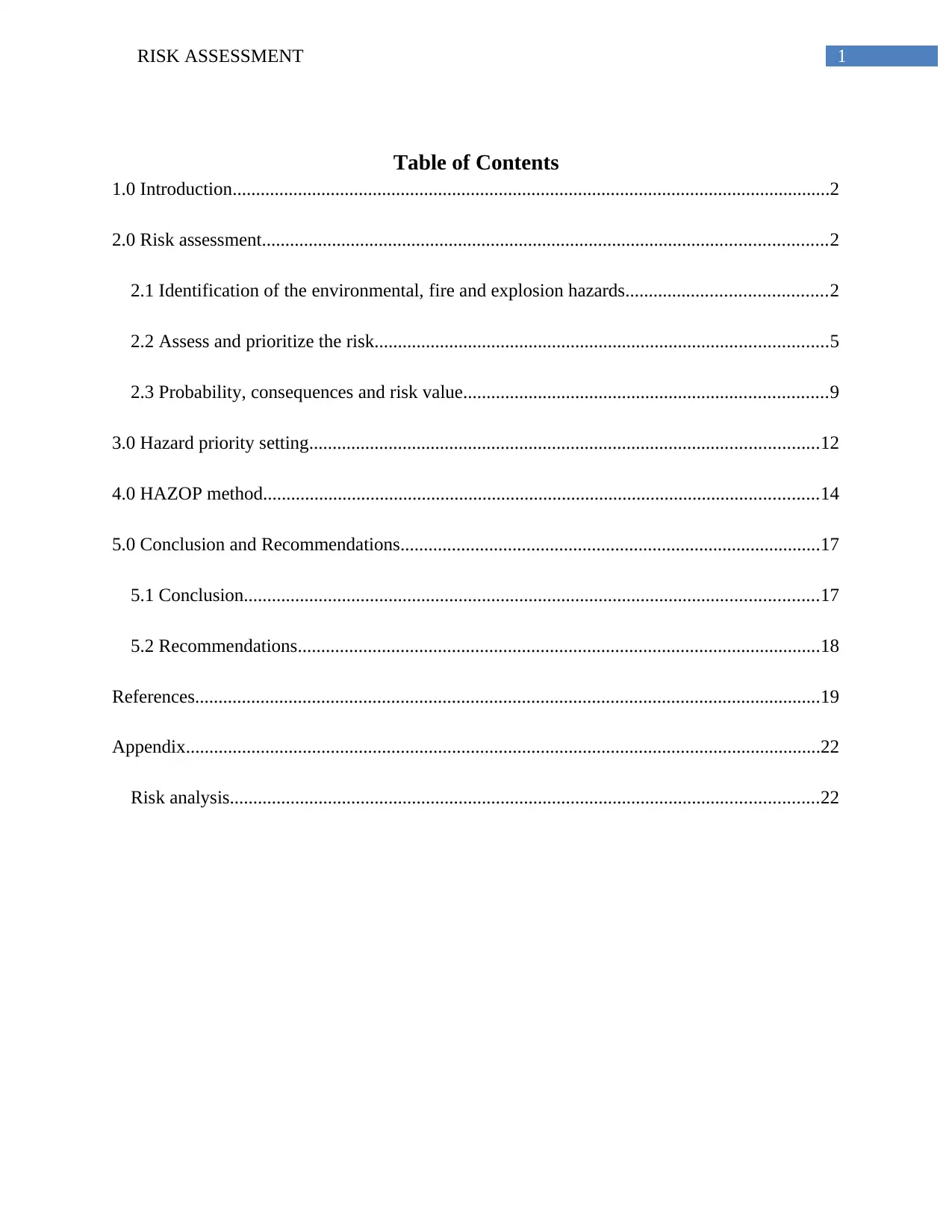
1RISK ASSESSMENT
Table of Contents
1.0 Introduction................................................................................................................................2
2.0 Risk assessment.........................................................................................................................2
2.1 Identification of the environmental, fire and explosion hazards...........................................2
2.2 Assess and prioritize the risk.................................................................................................5
2.3 Probability, consequences and risk value..............................................................................9
3.0 Hazard priority setting.............................................................................................................12
4.0 HAZOP method.......................................................................................................................14
5.0 Conclusion and Recommendations..........................................................................................17
5.1 Conclusion...........................................................................................................................17
5.2 Recommendations................................................................................................................18
References......................................................................................................................................19
Appendix........................................................................................................................................22
Risk analysis..............................................................................................................................22
Table of Contents
1.0 Introduction................................................................................................................................2
2.0 Risk assessment.........................................................................................................................2
2.1 Identification of the environmental, fire and explosion hazards...........................................2
2.2 Assess and prioritize the risk.................................................................................................5
2.3 Probability, consequences and risk value..............................................................................9
3.0 Hazard priority setting.............................................................................................................12
4.0 HAZOP method.......................................................................................................................14
5.0 Conclusion and Recommendations..........................................................................................17
5.1 Conclusion...........................................................................................................................17
5.2 Recommendations................................................................................................................18
References......................................................................................................................................19
Appendix........................................................................................................................................22
Risk analysis..............................................................................................................................22
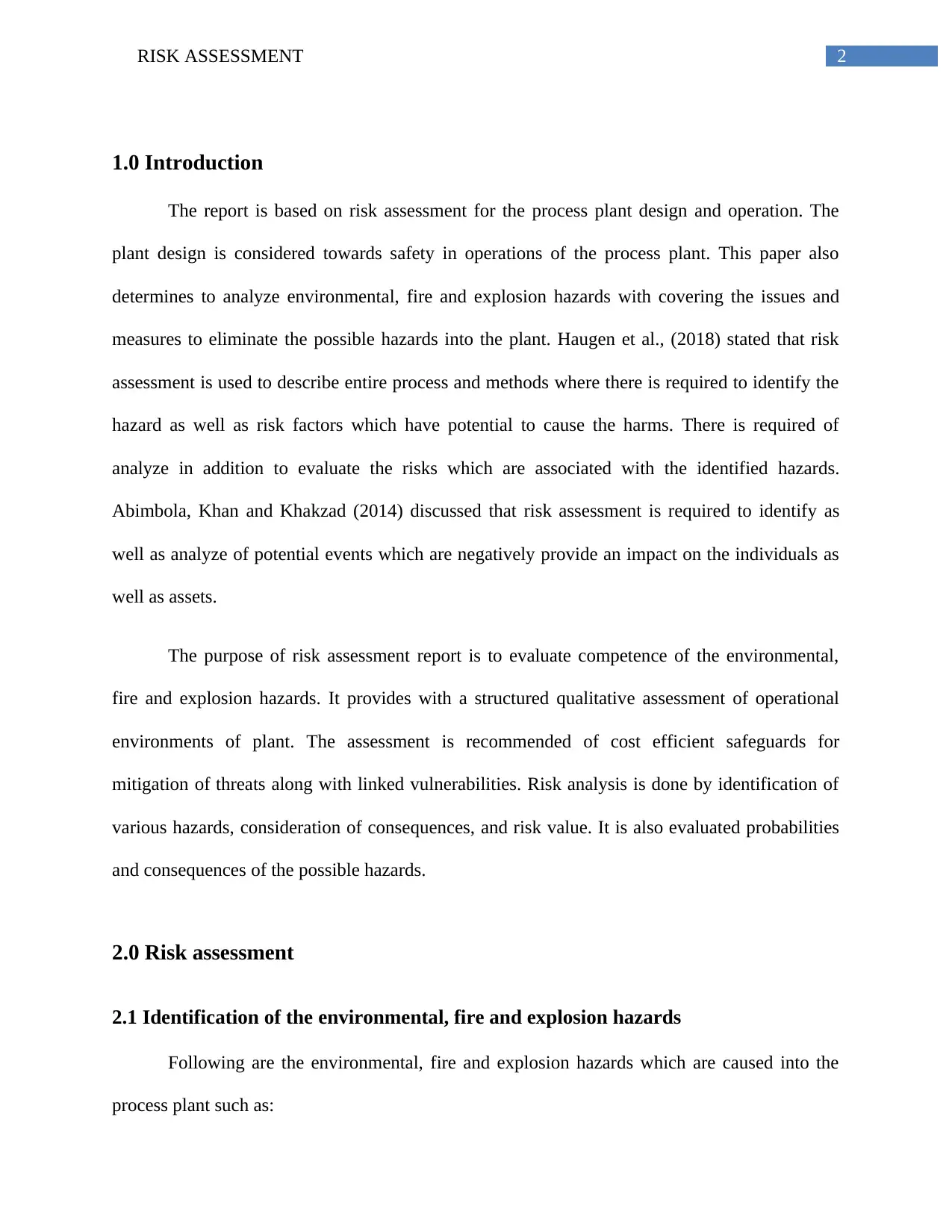
2RISK ASSESSMENT
1.0 Introduction
The report is based on risk assessment for the process plant design and operation. The
plant design is considered towards safety in operations of the process plant. This paper also
determines to analyze environmental, fire and explosion hazards with covering the issues and
measures to eliminate the possible hazards into the plant. Haugen et al., (2018) stated that risk
assessment is used to describe entire process and methods where there is required to identify the
hazard as well as risk factors which have potential to cause the harms. There is required of
analyze in addition to evaluate the risks which are associated with the identified hazards.
Abimbola, Khan and Khakzad (2014) discussed that risk assessment is required to identify as
well as analyze of potential events which are negatively provide an impact on the individuals as
well as assets.
The purpose of risk assessment report is to evaluate competence of the environmental,
fire and explosion hazards. It provides with a structured qualitative assessment of operational
environments of plant. The assessment is recommended of cost efficient safeguards for
mitigation of threats along with linked vulnerabilities. Risk analysis is done by identification of
various hazards, consideration of consequences, and risk value. It is also evaluated probabilities
and consequences of the possible hazards.
2.0 Risk assessment
2.1 Identification of the environmental, fire and explosion hazards
Following are the environmental, fire and explosion hazards which are caused into the
process plant such as:
1.0 Introduction
The report is based on risk assessment for the process plant design and operation. The
plant design is considered towards safety in operations of the process plant. This paper also
determines to analyze environmental, fire and explosion hazards with covering the issues and
measures to eliminate the possible hazards into the plant. Haugen et al., (2018) stated that risk
assessment is used to describe entire process and methods where there is required to identify the
hazard as well as risk factors which have potential to cause the harms. There is required of
analyze in addition to evaluate the risks which are associated with the identified hazards.
Abimbola, Khan and Khakzad (2014) discussed that risk assessment is required to identify as
well as analyze of potential events which are negatively provide an impact on the individuals as
well as assets.
The purpose of risk assessment report is to evaluate competence of the environmental,
fire and explosion hazards. It provides with a structured qualitative assessment of operational
environments of plant. The assessment is recommended of cost efficient safeguards for
mitigation of threats along with linked vulnerabilities. Risk analysis is done by identification of
various hazards, consideration of consequences, and risk value. It is also evaluated probabilities
and consequences of the possible hazards.
2.0 Risk assessment
2.1 Identification of the environmental, fire and explosion hazards
Following are the environmental, fire and explosion hazards which are caused into the
process plant such as:
⊘ This is a preview!⊘
Do you want full access?
Subscribe today to unlock all pages.

Trusted by 1+ million students worldwide
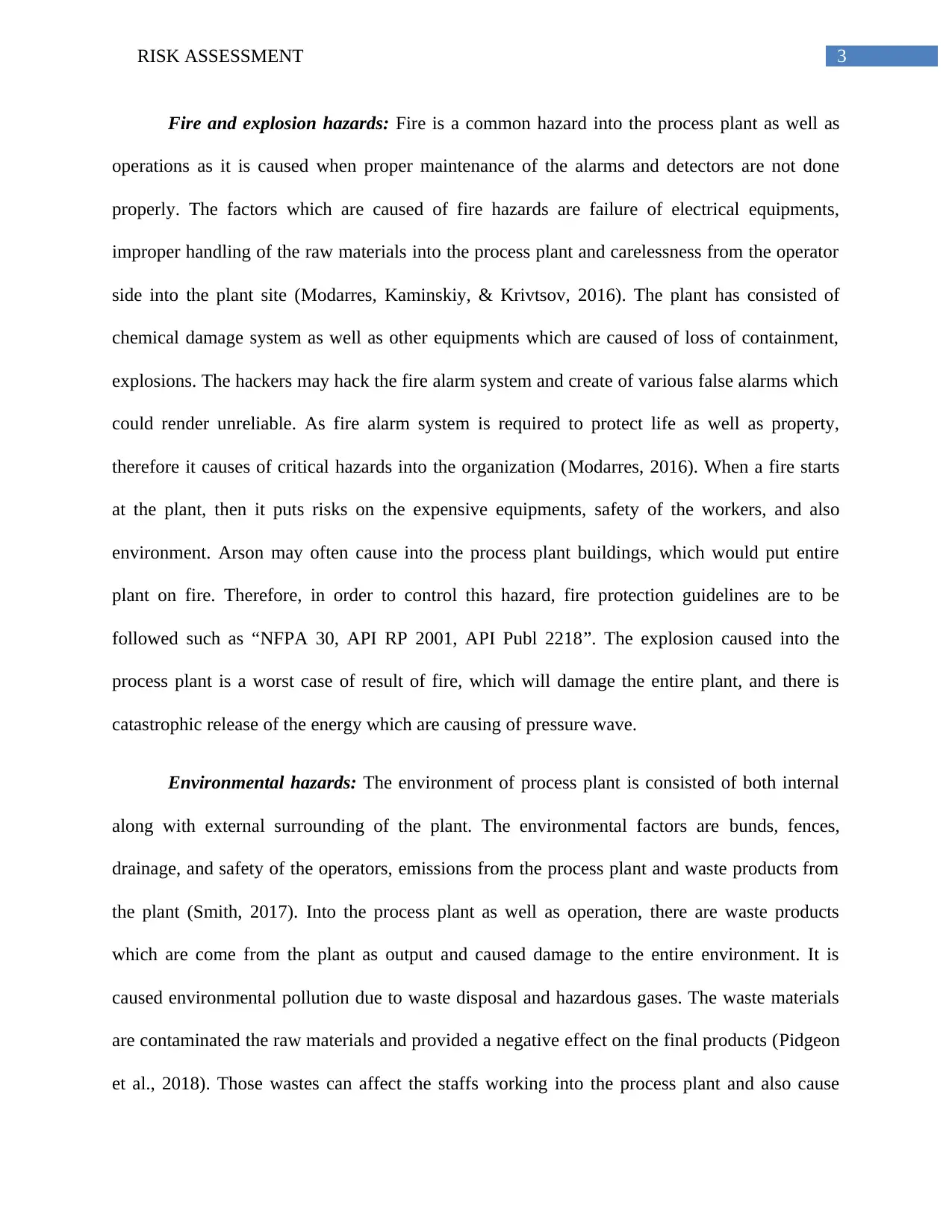
3RISK ASSESSMENT
Fire and explosion hazards: Fire is a common hazard into the process plant as well as
operations as it is caused when proper maintenance of the alarms and detectors are not done
properly. The factors which are caused of fire hazards are failure of electrical equipments,
improper handling of the raw materials into the process plant and carelessness from the operator
side into the plant site (Modarres, Kaminskiy, & Krivtsov, 2016). The plant has consisted of
chemical damage system as well as other equipments which are caused of loss of containment,
explosions. The hackers may hack the fire alarm system and create of various false alarms which
could render unreliable. As fire alarm system is required to protect life as well as property,
therefore it causes of critical hazards into the organization (Modarres, 2016). When a fire starts
at the plant, then it puts risks on the expensive equipments, safety of the workers, and also
environment. Arson may often cause into the process plant buildings, which would put entire
plant on fire. Therefore, in order to control this hazard, fire protection guidelines are to be
followed such as “NFPA 30, API RP 2001, API Publ 2218”. The explosion caused into the
process plant is a worst case of result of fire, which will damage the entire plant, and there is
catastrophic release of the energy which are causing of pressure wave.
Environmental hazards: The environment of process plant is consisted of both internal
along with external surrounding of the plant. The environmental factors are bunds, fences,
drainage, and safety of the operators, emissions from the process plant and waste products from
the plant (Smith, 2017). Into the process plant as well as operation, there are waste products
which are come from the plant as output and caused damage to the entire environment. It is
caused environmental pollution due to waste disposal and hazardous gases. The waste materials
are contaminated the raw materials and provided a negative effect on the final products (Pidgeon
et al., 2018). Those wastes can affect the staffs working into the process plant and also cause
Fire and explosion hazards: Fire is a common hazard into the process plant as well as
operations as it is caused when proper maintenance of the alarms and detectors are not done
properly. The factors which are caused of fire hazards are failure of electrical equipments,
improper handling of the raw materials into the process plant and carelessness from the operator
side into the plant site (Modarres, Kaminskiy, & Krivtsov, 2016). The plant has consisted of
chemical damage system as well as other equipments which are caused of loss of containment,
explosions. The hackers may hack the fire alarm system and create of various false alarms which
could render unreliable. As fire alarm system is required to protect life as well as property,
therefore it causes of critical hazards into the organization (Modarres, 2016). When a fire starts
at the plant, then it puts risks on the expensive equipments, safety of the workers, and also
environment. Arson may often cause into the process plant buildings, which would put entire
plant on fire. Therefore, in order to control this hazard, fire protection guidelines are to be
followed such as “NFPA 30, API RP 2001, API Publ 2218”. The explosion caused into the
process plant is a worst case of result of fire, which will damage the entire plant, and there is
catastrophic release of the energy which are causing of pressure wave.
Environmental hazards: The environment of process plant is consisted of both internal
along with external surrounding of the plant. The environmental factors are bunds, fences,
drainage, and safety of the operators, emissions from the process plant and waste products from
the plant (Smith, 2017). Into the process plant as well as operation, there are waste products
which are come from the plant as output and caused damage to the entire environment. It is
caused environmental pollution due to waste disposal and hazardous gases. The waste materials
are contaminated the raw materials and provided a negative effect on the final products (Pidgeon
et al., 2018). Those wastes can affect the staffs working into the process plant and also cause
Paraphrase This Document
Need a fresh take? Get an instant paraphrase of this document with our AI Paraphraser
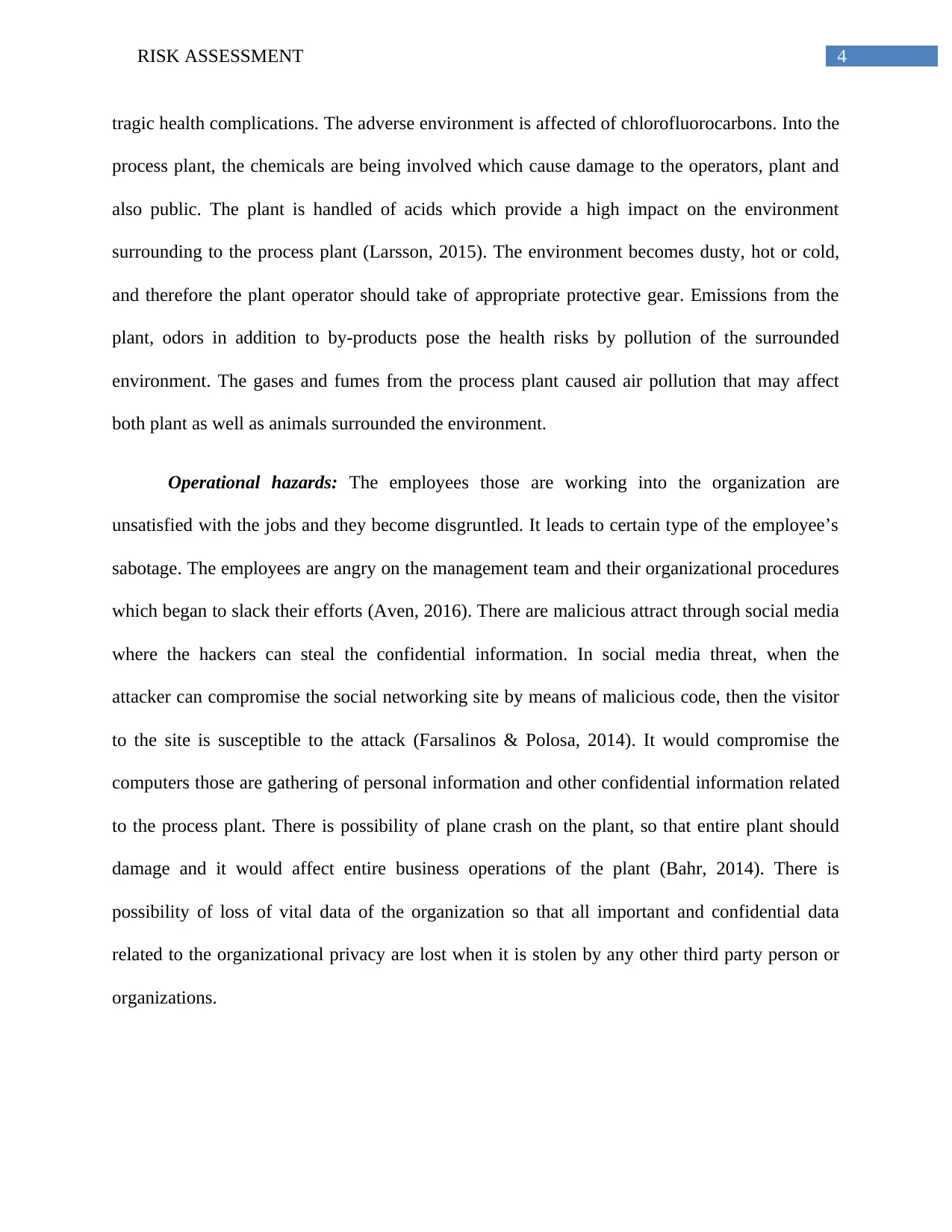
4RISK ASSESSMENT
tragic health complications. The adverse environment is affected of chlorofluorocarbons. Into the
process plant, the chemicals are being involved which cause damage to the operators, plant and
also public. The plant is handled of acids which provide a high impact on the environment
surrounding to the process plant (Larsson, 2015). The environment becomes dusty, hot or cold,
and therefore the plant operator should take of appropriate protective gear. Emissions from the
plant, odors in addition to by-products pose the health risks by pollution of the surrounded
environment. The gases and fumes from the process plant caused air pollution that may affect
both plant as well as animals surrounded the environment.
Operational hazards: The employees those are working into the organization are
unsatisfied with the jobs and they become disgruntled. It leads to certain type of the employee’s
sabotage. The employees are angry on the management team and their organizational procedures
which began to slack their efforts (Aven, 2016). There are malicious attract through social media
where the hackers can steal the confidential information. In social media threat, when the
attacker can compromise the social networking site by means of malicious code, then the visitor
to the site is susceptible to the attack (Farsalinos & Polosa, 2014). It would compromise the
computers those are gathering of personal information and other confidential information related
to the process plant. There is possibility of plane crash on the plant, so that entire plant should
damage and it would affect entire business operations of the plant (Bahr, 2014). There is
possibility of loss of vital data of the organization so that all important and confidential data
related to the organizational privacy are lost when it is stolen by any other third party person or
organizations.
tragic health complications. The adverse environment is affected of chlorofluorocarbons. Into the
process plant, the chemicals are being involved which cause damage to the operators, plant and
also public. The plant is handled of acids which provide a high impact on the environment
surrounding to the process plant (Larsson, 2015). The environment becomes dusty, hot or cold,
and therefore the plant operator should take of appropriate protective gear. Emissions from the
plant, odors in addition to by-products pose the health risks by pollution of the surrounded
environment. The gases and fumes from the process plant caused air pollution that may affect
both plant as well as animals surrounded the environment.
Operational hazards: The employees those are working into the organization are
unsatisfied with the jobs and they become disgruntled. It leads to certain type of the employee’s
sabotage. The employees are angry on the management team and their organizational procedures
which began to slack their efforts (Aven, 2016). There are malicious attract through social media
where the hackers can steal the confidential information. In social media threat, when the
attacker can compromise the social networking site by means of malicious code, then the visitor
to the site is susceptible to the attack (Farsalinos & Polosa, 2014). It would compromise the
computers those are gathering of personal information and other confidential information related
to the process plant. There is possibility of plane crash on the plant, so that entire plant should
damage and it would affect entire business operations of the plant (Bahr, 2014). There is
possibility of loss of vital data of the organization so that all important and confidential data
related to the organizational privacy are lost when it is stolen by any other third party person or
organizations.
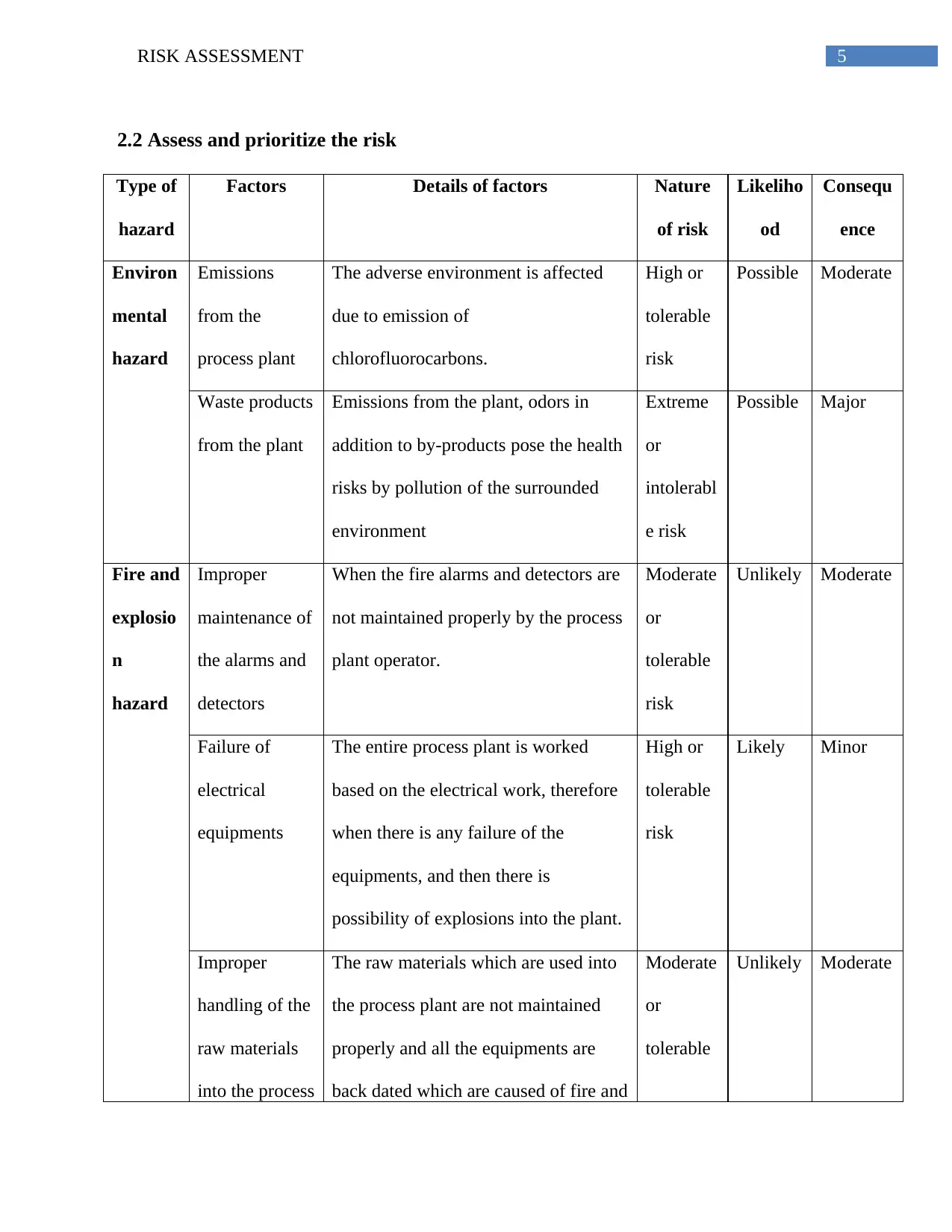
5RISK ASSESSMENT
2.2 Assess and prioritize the risk
Type of
hazard
Factors Details of factors Nature
of risk
Likeliho
od
Consequ
ence
Environ
mental
hazard
Emissions
from the
process plant
The adverse environment is affected
due to emission of
chlorofluorocarbons.
High or
tolerable
risk
Possible Moderate
Waste products
from the plant
Emissions from the plant, odors in
addition to by-products pose the health
risks by pollution of the surrounded
environment
Extreme
or
intolerabl
e risk
Possible Major
Fire and
explosio
n
hazard
Improper
maintenance of
the alarms and
detectors
When the fire alarms and detectors are
not maintained properly by the process
plant operator.
Moderate
or
tolerable
risk
Unlikely Moderate
Failure of
electrical
equipments
The entire process plant is worked
based on the electrical work, therefore
when there is any failure of the
equipments, and then there is
possibility of explosions into the plant.
High or
tolerable
risk
Likely Minor
Improper
handling of the
raw materials
into the process
The raw materials which are used into
the process plant are not maintained
properly and all the equipments are
back dated which are caused of fire and
Moderate
or
tolerable
Unlikely Moderate
2.2 Assess and prioritize the risk
Type of
hazard
Factors Details of factors Nature
of risk
Likeliho
od
Consequ
ence
Environ
mental
hazard
Emissions
from the
process plant
The adverse environment is affected
due to emission of
chlorofluorocarbons.
High or
tolerable
risk
Possible Moderate
Waste products
from the plant
Emissions from the plant, odors in
addition to by-products pose the health
risks by pollution of the surrounded
environment
Extreme
or
intolerabl
e risk
Possible Major
Fire and
explosio
n
hazard
Improper
maintenance of
the alarms and
detectors
When the fire alarms and detectors are
not maintained properly by the process
plant operator.
Moderate
or
tolerable
risk
Unlikely Moderate
Failure of
electrical
equipments
The entire process plant is worked
based on the electrical work, therefore
when there is any failure of the
equipments, and then there is
possibility of explosions into the plant.
High or
tolerable
risk
Likely Minor
Improper
handling of the
raw materials
into the process
The raw materials which are used into
the process plant are not maintained
properly and all the equipments are
back dated which are caused of fire and
Moderate
or
tolerable
Unlikely Moderate
⊘ This is a preview!⊘
Do you want full access?
Subscribe today to unlock all pages.

Trusted by 1+ million students worldwide
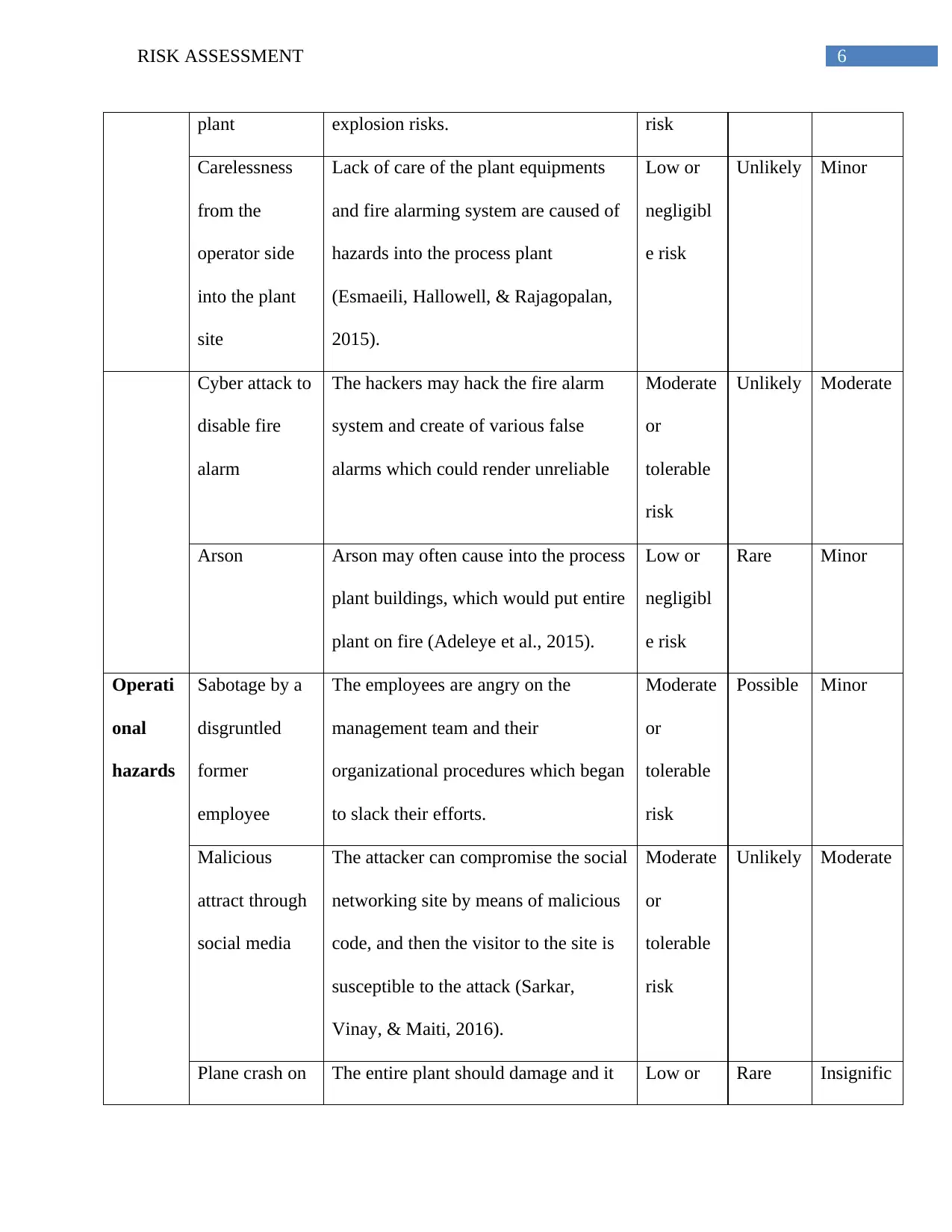
6RISK ASSESSMENT
plant explosion risks. risk
Carelessness
from the
operator side
into the plant
site
Lack of care of the plant equipments
and fire alarming system are caused of
hazards into the process plant
(Esmaeili, Hallowell, & Rajagopalan,
2015).
Low or
negligibl
e risk
Unlikely Minor
Cyber attack to
disable fire
alarm
The hackers may hack the fire alarm
system and create of various false
alarms which could render unreliable
Moderate
or
tolerable
risk
Unlikely Moderate
Arson Arson may often cause into the process
plant buildings, which would put entire
plant on fire (Adeleye et al., 2015).
Low or
negligibl
e risk
Rare Minor
Operati
onal
hazards
Sabotage by a
disgruntled
former
employee
The employees are angry on the
management team and their
organizational procedures which began
to slack their efforts.
Moderate
or
tolerable
risk
Possible Minor
Malicious
attract through
social media
The attacker can compromise the social
networking site by means of malicious
code, and then the visitor to the site is
susceptible to the attack (Sarkar,
Vinay, & Maiti, 2016).
Moderate
or
tolerable
risk
Unlikely Moderate
Plane crash on The entire plant should damage and it Low or Rare Insignific
plant explosion risks. risk
Carelessness
from the
operator side
into the plant
site
Lack of care of the plant equipments
and fire alarming system are caused of
hazards into the process plant
(Esmaeili, Hallowell, & Rajagopalan,
2015).
Low or
negligibl
e risk
Unlikely Minor
Cyber attack to
disable fire
alarm
The hackers may hack the fire alarm
system and create of various false
alarms which could render unreliable
Moderate
or
tolerable
risk
Unlikely Moderate
Arson Arson may often cause into the process
plant buildings, which would put entire
plant on fire (Adeleye et al., 2015).
Low or
negligibl
e risk
Rare Minor
Operati
onal
hazards
Sabotage by a
disgruntled
former
employee
The employees are angry on the
management team and their
organizational procedures which began
to slack their efforts.
Moderate
or
tolerable
risk
Possible Minor
Malicious
attract through
social media
The attacker can compromise the social
networking site by means of malicious
code, and then the visitor to the site is
susceptible to the attack (Sarkar,
Vinay, & Maiti, 2016).
Moderate
or
tolerable
risk
Unlikely Moderate
Plane crash on The entire plant should damage and it Low or Rare Insignific
Paraphrase This Document
Need a fresh take? Get an instant paraphrase of this document with our AI Paraphraser
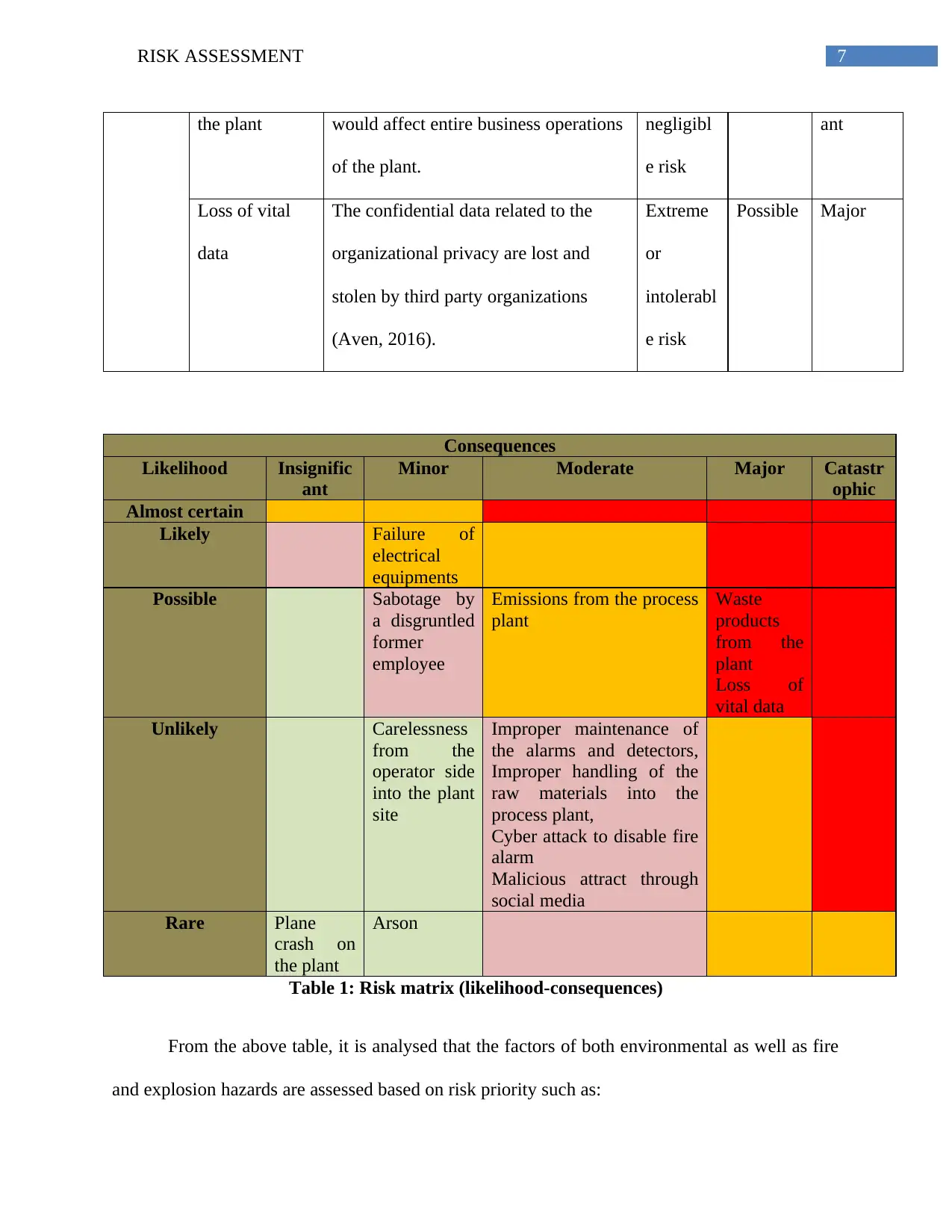
7RISK ASSESSMENT
the plant would affect entire business operations
of the plant.
negligibl
e risk
ant
Loss of vital
data
The confidential data related to the
organizational privacy are lost and
stolen by third party organizations
(Aven, 2016).
Extreme
or
intolerabl
e risk
Possible Major
Consequences
Likelihood Insignific
ant
Minor Moderate Major Catastr
ophic
Almost certain
Likely Failure of
electrical
equipments
Possible Sabotage by
a disgruntled
former
employee
Emissions from the process
plant
Waste
products
from the
plant
Loss of
vital data
Unlikely Carelessness
from the
operator side
into the plant
site
Improper maintenance of
the alarms and detectors,
Improper handling of the
raw materials into the
process plant,
Cyber attack to disable fire
alarm
Malicious attract through
social media
Rare Plane
crash on
the plant
Arson
Table 1: Risk matrix (likelihood-consequences)
From the above table, it is analysed that the factors of both environmental as well as fire
and explosion hazards are assessed based on risk priority such as:
the plant would affect entire business operations
of the plant.
negligibl
e risk
ant
Loss of vital
data
The confidential data related to the
organizational privacy are lost and
stolen by third party organizations
(Aven, 2016).
Extreme
or
intolerabl
e risk
Possible Major
Consequences
Likelihood Insignific
ant
Minor Moderate Major Catastr
ophic
Almost certain
Likely Failure of
electrical
equipments
Possible Sabotage by
a disgruntled
former
employee
Emissions from the process
plant
Waste
products
from the
plant
Loss of
vital data
Unlikely Carelessness
from the
operator side
into the plant
site
Improper maintenance of
the alarms and detectors,
Improper handling of the
raw materials into the
process plant,
Cyber attack to disable fire
alarm
Malicious attract through
social media
Rare Plane
crash on
the plant
Arson
Table 1: Risk matrix (likelihood-consequences)
From the above table, it is analysed that the factors of both environmental as well as fire
and explosion hazards are assessed based on risk priority such as:
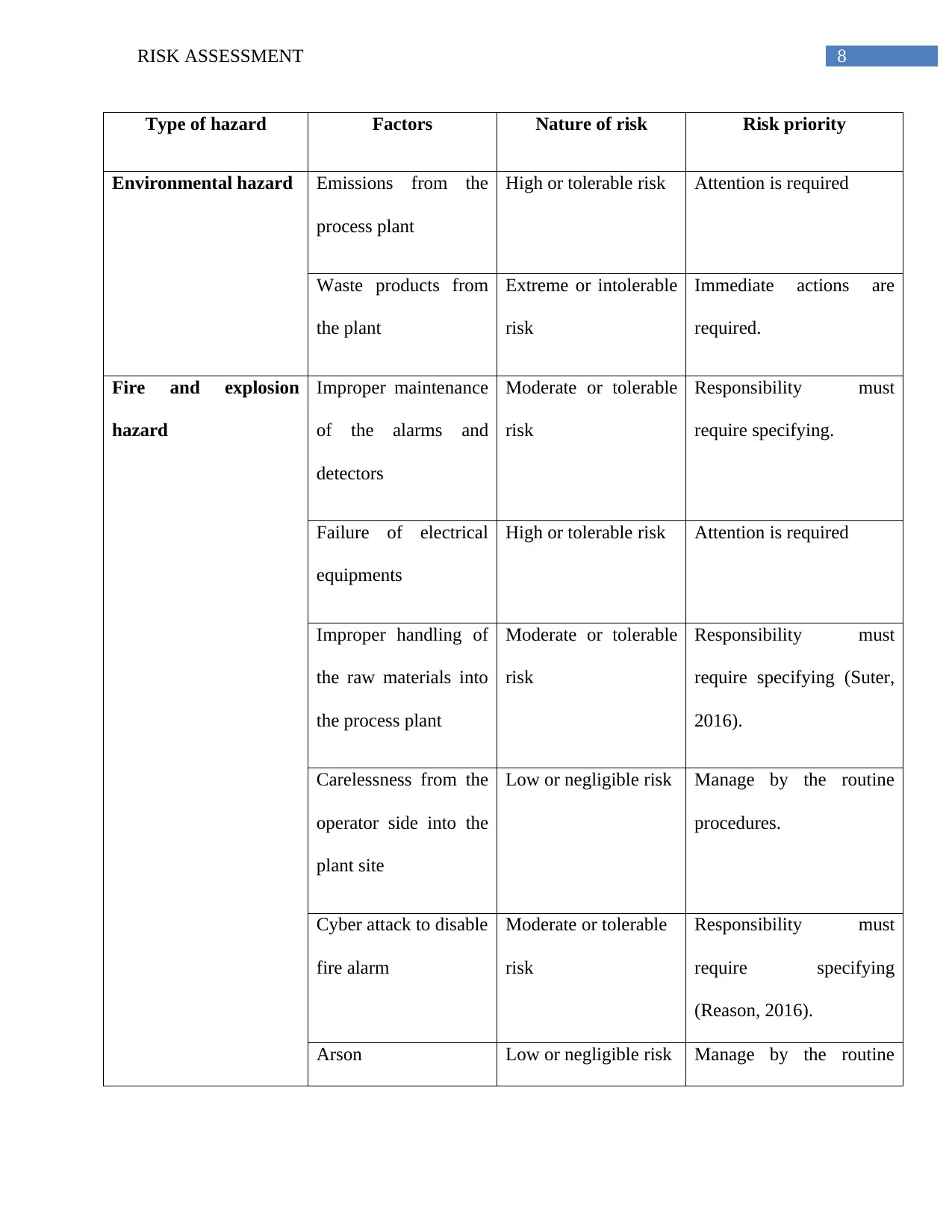
8RISK ASSESSMENT
Type of hazard Factors Nature of risk Risk priority
Environmental hazard Emissions from the
process plant
High or tolerable risk Attention is required
Waste products from
the plant
Extreme or intolerable
risk
Immediate actions are
required.
Fire and explosion
hazard
Improper maintenance
of the alarms and
detectors
Moderate or tolerable
risk
Responsibility must
require specifying.
Failure of electrical
equipments
High or tolerable risk Attention is required
Improper handling of
the raw materials into
the process plant
Moderate or tolerable
risk
Responsibility must
require specifying (Suter,
2016).
Carelessness from the
operator side into the
plant site
Low or negligible risk Manage by the routine
procedures.
Cyber attack to disable
fire alarm
Moderate or tolerable
risk
Responsibility must
require specifying
(Reason, 2016).
Arson Low or negligible risk Manage by the routine
Type of hazard Factors Nature of risk Risk priority
Environmental hazard Emissions from the
process plant
High or tolerable risk Attention is required
Waste products from
the plant
Extreme or intolerable
risk
Immediate actions are
required.
Fire and explosion
hazard
Improper maintenance
of the alarms and
detectors
Moderate or tolerable
risk
Responsibility must
require specifying.
Failure of electrical
equipments
High or tolerable risk Attention is required
Improper handling of
the raw materials into
the process plant
Moderate or tolerable
risk
Responsibility must
require specifying (Suter,
2016).
Carelessness from the
operator side into the
plant site
Low or negligible risk Manage by the routine
procedures.
Cyber attack to disable
fire alarm
Moderate or tolerable
risk
Responsibility must
require specifying
(Reason, 2016).
Arson Low or negligible risk Manage by the routine
⊘ This is a preview!⊘
Do you want full access?
Subscribe today to unlock all pages.

Trusted by 1+ million students worldwide
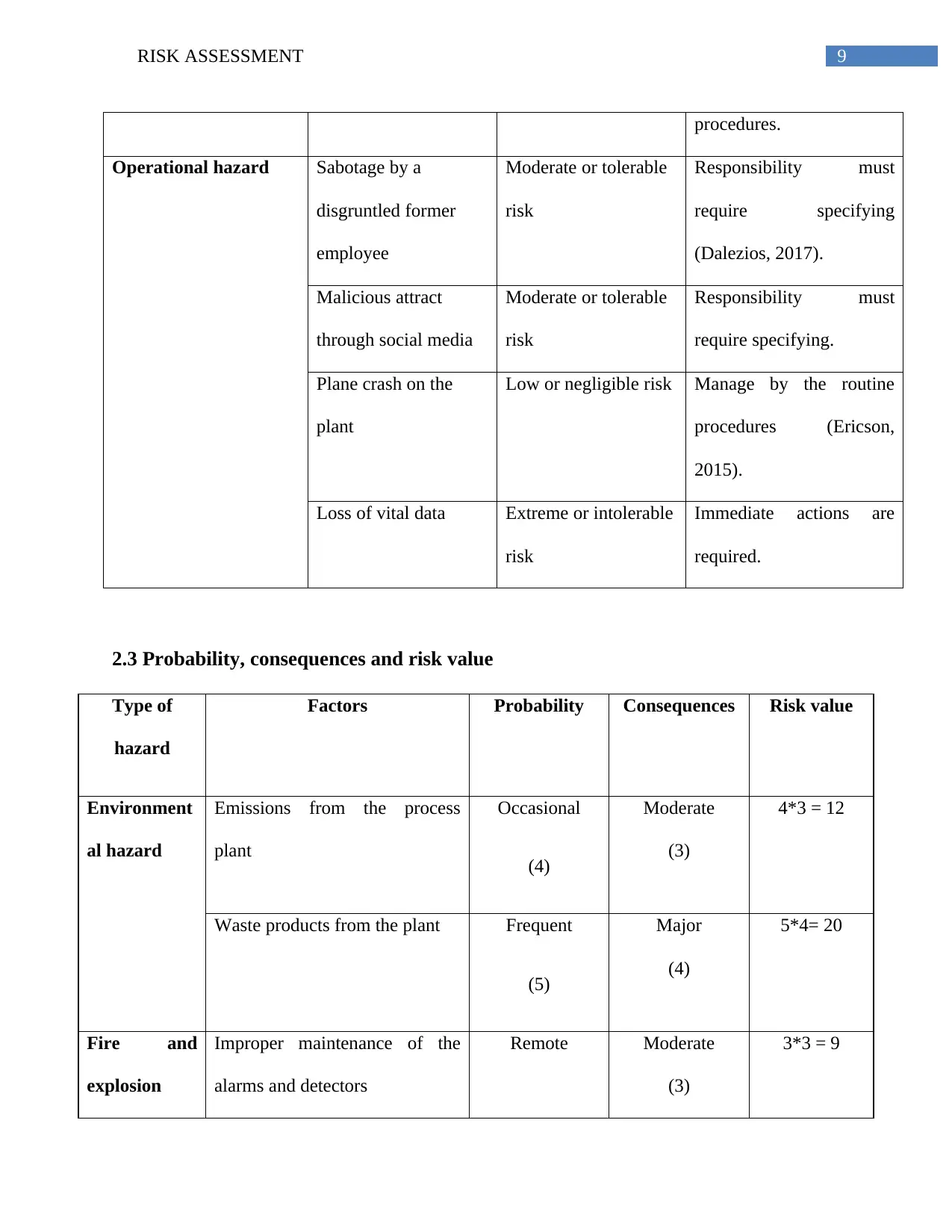
9RISK ASSESSMENT
procedures.
Operational hazard Sabotage by a
disgruntled former
employee
Moderate or tolerable
risk
Responsibility must
require specifying
(Dalezios, 2017).
Malicious attract
through social media
Moderate or tolerable
risk
Responsibility must
require specifying.
Plane crash on the
plant
Low or negligible risk Manage by the routine
procedures (Ericson,
2015).
Loss of vital data Extreme or intolerable
risk
Immediate actions are
required.
2.3 Probability, consequences and risk value
Type of
hazard
Factors Probability Consequences Risk value
Environment
al hazard
Emissions from the process
plant
Occasional
(4)
Moderate
(3)
4*3 = 12
Waste products from the plant Frequent
(5)
Major
(4)
5*4= 20
Fire and
explosion
Improper maintenance of the
alarms and detectors
Remote Moderate
(3)
3*3 = 9
procedures.
Operational hazard Sabotage by a
disgruntled former
employee
Moderate or tolerable
risk
Responsibility must
require specifying
(Dalezios, 2017).
Malicious attract
through social media
Moderate or tolerable
risk
Responsibility must
require specifying.
Plane crash on the
plant
Low or negligible risk Manage by the routine
procedures (Ericson,
2015).
Loss of vital data Extreme or intolerable
risk
Immediate actions are
required.
2.3 Probability, consequences and risk value
Type of
hazard
Factors Probability Consequences Risk value
Environment
al hazard
Emissions from the process
plant
Occasional
(4)
Moderate
(3)
4*3 = 12
Waste products from the plant Frequent
(5)
Major
(4)
5*4= 20
Fire and
explosion
Improper maintenance of the
alarms and detectors
Remote Moderate
(3)
3*3 = 9
Paraphrase This Document
Need a fresh take? Get an instant paraphrase of this document with our AI Paraphraser

10RISK ASSESSMENT
hazard (3)
Failure of electrical equipments Unlikely
(2)
Minor
(2)
2*2= 4
Improper handling of the raw
materials into the process plant
Occasional
(4)
Moderate
(3)
4*3= 12
Carelessness from the operator
side into the plant site
(Lundgren & McMakin, 2018)
Remote
(3)
Minor
(2)
3*2= 6
Cyber attack to disable fire
alarm
Remote
(3)
Moderate
(3)
3*3 = 9
Arson Rare
(1)
Insignificant
(1)
1*1= 1
Operational
hazard
Sabotage by a disgruntled
former employee
Remote
(3)
Minor
(2)
3*2= 6
Malicious attract through social
media
Occasional
(4)
Minor
(2)
4*2= 8
Plane crash on the plant Rare
(1)
Insignificant
(1)
1*1= 1
Loss of vital data Remote Moderate 3*3 = 9
hazard (3)
Failure of electrical equipments Unlikely
(2)
Minor
(2)
2*2= 4
Improper handling of the raw
materials into the process plant
Occasional
(4)
Moderate
(3)
4*3= 12
Carelessness from the operator
side into the plant site
(Lundgren & McMakin, 2018)
Remote
(3)
Minor
(2)
3*2= 6
Cyber attack to disable fire
alarm
Remote
(3)
Moderate
(3)
3*3 = 9
Arson Rare
(1)
Insignificant
(1)
1*1= 1
Operational
hazard
Sabotage by a disgruntled
former employee
Remote
(3)
Minor
(2)
3*2= 6
Malicious attract through social
media
Occasional
(4)
Minor
(2)
4*2= 8
Plane crash on the plant Rare
(1)
Insignificant
(1)
1*1= 1
Loss of vital data Remote Moderate 3*3 = 9
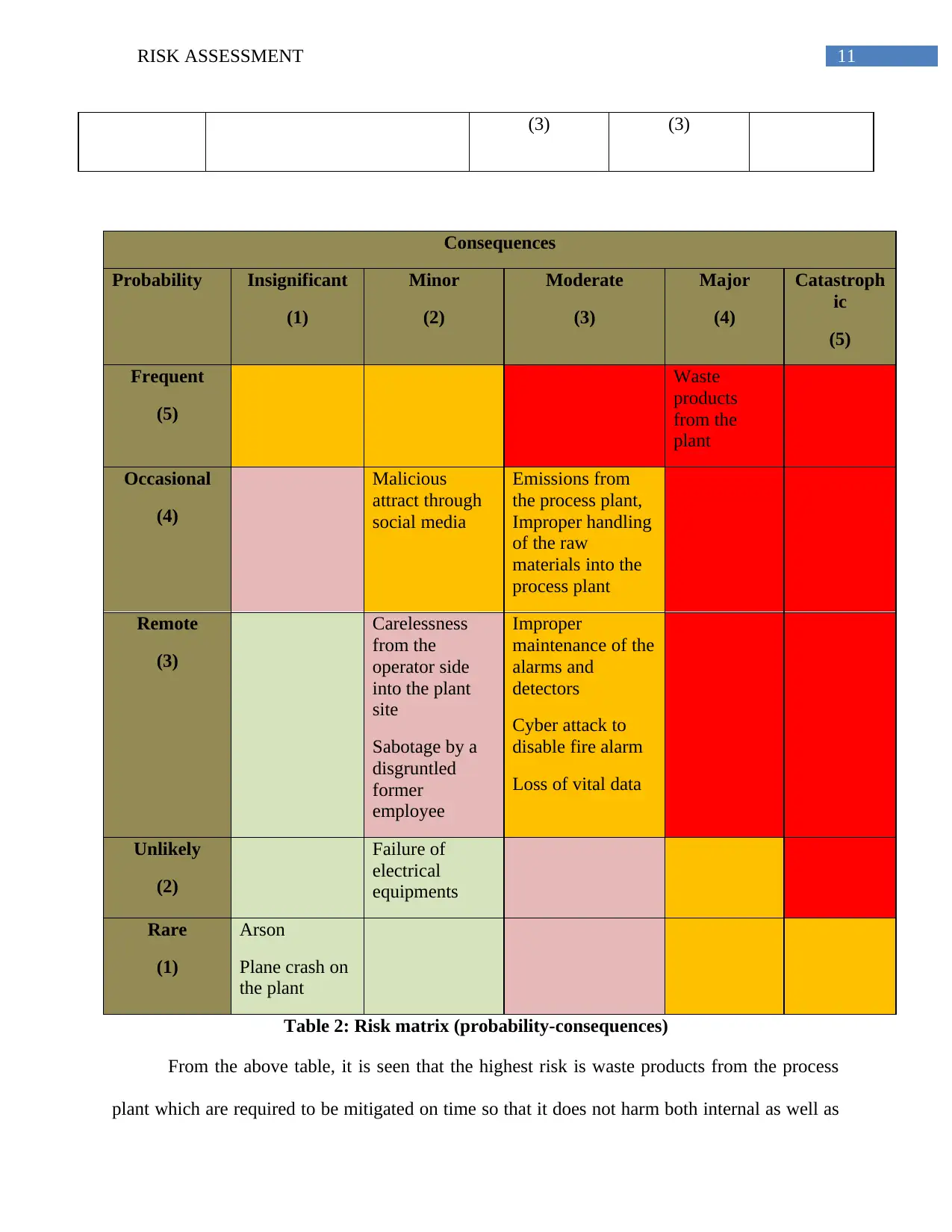
11RISK ASSESSMENT
(3) (3)
Consequences
Probability Insignificant
(1)
Minor
(2)
Moderate
(3)
Major
(4)
Catastroph
ic
(5)
Frequent
(5)
Waste
products
from the
plant
Occasional
(4)
Malicious
attract through
social media
Emissions from
the process plant,
Improper handling
of the raw
materials into the
process plant
Remote
(3)
Carelessness
from the
operator side
into the plant
site
Sabotage by a
disgruntled
former
employee
Improper
maintenance of the
alarms and
detectors
Cyber attack to
disable fire alarm
Loss of vital data
Unlikely
(2)
Failure of
electrical
equipments
Rare
(1)
Arson
Plane crash on
the plant
Table 2: Risk matrix (probability-consequences)
From the above table, it is seen that the highest risk is waste products from the process
plant which are required to be mitigated on time so that it does not harm both internal as well as
(3) (3)
Consequences
Probability Insignificant
(1)
Minor
(2)
Moderate
(3)
Major
(4)
Catastroph
ic
(5)
Frequent
(5)
Waste
products
from the
plant
Occasional
(4)
Malicious
attract through
social media
Emissions from
the process plant,
Improper handling
of the raw
materials into the
process plant
Remote
(3)
Carelessness
from the
operator side
into the plant
site
Sabotage by a
disgruntled
former
employee
Improper
maintenance of the
alarms and
detectors
Cyber attack to
disable fire alarm
Loss of vital data
Unlikely
(2)
Failure of
electrical
equipments
Rare
(1)
Arson
Plane crash on
the plant
Table 2: Risk matrix (probability-consequences)
From the above table, it is seen that the highest risk is waste products from the process
plant which are required to be mitigated on time so that it does not harm both internal as well as
⊘ This is a preview!⊘
Do you want full access?
Subscribe today to unlock all pages.

Trusted by 1+ million students worldwide
1 out of 24
Related Documents
Your All-in-One AI-Powered Toolkit for Academic Success.
+13062052269
info@desklib.com
Available 24*7 on WhatsApp / Email
![[object Object]](/_next/static/media/star-bottom.7253800d.svg)
Unlock your academic potential
Copyright © 2020–2025 A2Z Services. All Rights Reserved. Developed and managed by ZUCOL.





